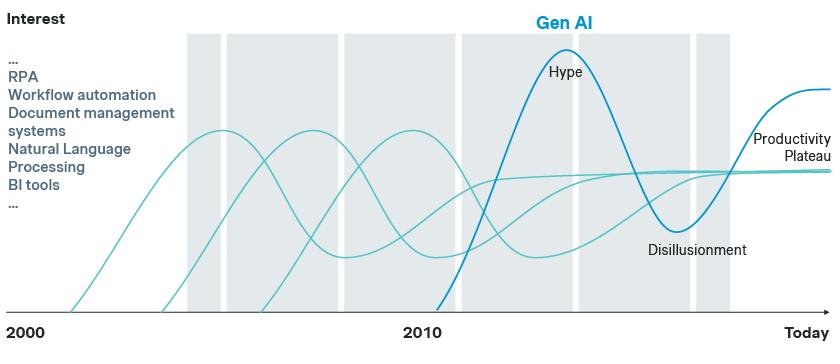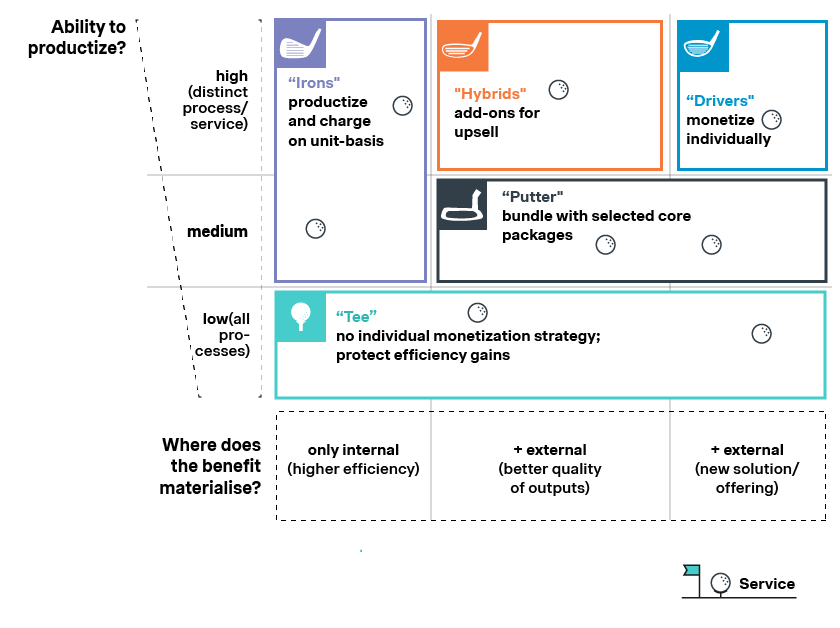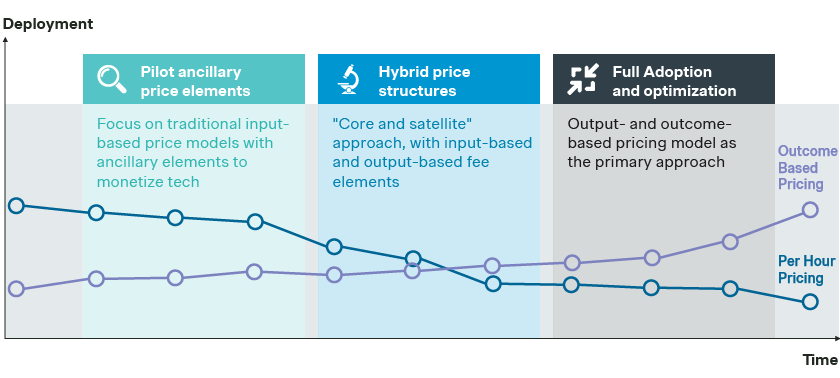With the advance of generative AI, areas once exclusive to human expertise and at the core of professional services now face the threat of being automated. As such, the technology has a huge impact on how firms will market and price their services. Learn from our experts how decade-old pricing models in the professional service industry are changing and how you can proactively shape the transformation with new price models.
The billable hour is dead, long live the billable hour! Often proclaimed dead, it’s hard to imagine a business world without time-based revenue models. Despite their flaws, the proportion of time- and materials-based revenue models doesn’t really seem to be dropping much. So, time is money – or is it?
With GenAI change is coming – first gradually, then fast – as our newest Simon-Kucher study reveals! Many jobs that have taken consultants, art directors, copywriters, and lawyers hours before, now only take minutes. And as efficiency gains increase, and time spent on tasks gets reduced, professional firms who rely on time-based billing should start thinking ahead.
New frontiers with GenAI: Are outcome-based pricing models on the rise?
Despite many shortcomings, time-and-materials based pricing models come with their benefits. They offer the ability to consistently bill for the work performed, offering a low-risk approach. This is especially important in services marked by little transparency in the “delivery”, when relying on trust-based services or when the outputs are ill-defined.
And while productivity gains (e.g., through digitalization and prior waves of automation technologies) are nothing really new in professional services, the pressure to adjust the price model has never been truly big enough. A whole ecosystem is built on the billable hour, from procurement departments that force price proposals in this format, to time tracking and billing tools.
Our experts predict that this time will be different: GenAI is not just a tool that humans use to speed up work, but a tool that can bring information into a digestible form much faster than any human worker could ever do.
Compared to previous tech innovations, GenAI’s impact is more profound. Because the technology affects so many services sub-sectors simultaneously (as well as different types of services and deliverables/solutions), a market dynamic will likely emerge. The revenue model revolution is near – this time for real.

GenAI’s impact compared to previous automatization and digitalization waves
So what is the next step for pricing? Just think ahead.
Outcome- or value-based pricing is on the horizon. It has been buzzing around as a phenomenon for years, but nobody has really cracked the nut yet. Why is that the case?
The arguments for and against new price models: Tennis is great, but did you ever consider playing golf?
Here are the five main challenges when transitioning the price model:
- Poorly defined deliverables, outcomes, and outputs: There is no real standardization in the services and every customer gets a fully customized service requiring high flexibility in quantifying service prices
- Lack of data for each individual service, be it costs, customer value or willingness to pay
- (Cost) variance in the delivery, which makes it often impossible to attach a (fixed) price tag to certain services
- Decentralization in professional services pricing, with each Partner setting prices for their own projects (and limited appetite to give up this commercial freedom / decentralized approach)
- Customer expectations and processes, with purchasing processes, systems, and tenders fully revolving around the time-materials-based pricing model
These barriers often seem insurmountable, so moving the professional services sector to true value-based pricing becomes a colossal task that no single player wants to spearhead.
Only if you think in binary terms. However, the pricing models in professional service firms will not be binary in the future. There won’t be only one dominant model, like in tennis the one racket, but a variety of models that have to be applied to specific situations. We are certain that the current GenAI trend will further grow and profoundly change the pricing models in professional services.
So when it comes to pricing: Think golf not tennis!
Because unlike tennis, where sticking to a single racket is crucial, golf often benefits from the versatile use of multiple clubs to achieve the most optimal outcome.
Following this analogy, we predict professional service firms’ pricing models to fundamentally shift in the next years to come, following a thoughtful and golf-like approach where a combination of different price models is used by leading service firms.
On the search for new revenue models: How can services be priced?
Our pricing experts so far have identified six high-level solutions in the professional service industry to integrate generative AI. These price model strategies can be combined and matched according to your firm’s need.
- Increase your hourly/day rates: Work is done faster with AI. Once this has a visible impact, working hours might start shrinking fast. An easy solution is to increase the hourly rates and stick to the traditional time-and-materials-based model to maintain revenue flows. The issue: You need to counter the challenge of potential client resistance to these higher rates (especially when competitors do not choose this approach).
- Introduce a multi-dimensional model: Another option is to keep the hourly rate-based price model in place and accept reductions in working time, but at the same time start charging technology or software licensing fees (e.g., to cover the for GenAI software and tech investments).
- Transition to a credit-based model: Specific activities and work can be charged after a credit-based model. The client buys credits (potentially on a subscription basis/as a retainer) and then uses them for your firm’s services. In this model, each service needs to be allocated a specific credit value which becomes a new currency. However, determining appropriate credit values and managing fluctuations in professional service demands may be complex to manage.
- Move to output-based pricing: Charge the “real value” for specific professional services. The idea is to tie payments to the delivered work product rather than the time spent. Despite creating transparency, the major challenge here is to define and measure the allocated service units. Some clients might also resist the departure from traditional price models.
- Move to flat rate pricing: Another option that can be also combined with the previous models is to change for a flat rate service. It creates predictability in pricing, but again the challenge arises in quantifying the service level and creating fair pricing.
- Introduce outcome-based pricing/gain share models: Choose a monetization model that charges the true value delivered for your clients – also adding the impact on every customer within the value chain of the service. For example, using a value based (innovation) pricing approach. This model is popular with a lot of software and in business B2B pricing, but depending on the business scenario, the real impact can be difficult to measure and to standardize.
The next step: Which services can be changed to the new price models first and where are the greatest opportunities?
To face the challenges of Generative AI, it is time to categorize your potential services. Once you have a clear overview, it is easier to deduct which pricing model you might need to charge fees for your services.
For business services that are clearly defined, have a clear output, and where generative AI has a well-defined impact, we recommend using an output-based pricing approach. For services where the GenAI impact is more directed toward internal efficiency and the customer is not necessarily aware of this, a two-dimensional model with a tech surcharge or similar might make the most sense.
Following the diagram below you can get an idea how well specific professional services can be transformed and monetized: From the traditional time-and-materials-based pricing to more innovative solutions.

Introducing pricing models to different services
By dissecting services along these two axes, delineating the processes and clearly looking at the benefits, professional service firms can create their own timeline for market introductions. Of course, our experts are also here to help you manage the change.
Evolution not revolution
We understand that there are reasons firms might hesitate to opt for the change. However, it’s always better to proactively manage the transformation instead of being driven by other companies and not having a choice to adopt the ideal price model.
Think evolution and not revolution: Gradually shift the balance from legacy to future-proof price models, in line with the pace of technological change and cultural change management. We know it’s not easy, but in a year from now you will wish you’d started a year ago. And if we look ahead five or ten years, with all the changes and impacts that AI brings to the workplace, who really still believes that the “billable” hour can survive the test of time?

Simon-Kucher project example of gradual price model transition
The problem remains: If you wait too long, AI’s efficiency gains might make your clients and customers benefit by paying less. So why wait much longer?
It’s time to switch your tennis racket to a set of golf clubs. Rather sooner than later.
Are you still hesitating? Uncertain how the future of your pricing looks?
Get in contact with us today. Our experts know how to set up ideal revenue models for your professional service firm. We understand the individual needs of every firm and develop a clear roadmap to bring the transformation forward – from the first small steps toward more nuanced pricing models and hybrid systems.
Don’t wait too long! Identify potential revenue leakages early on and become a change driver in the professional service industry. It’s finally time to learn golf.


